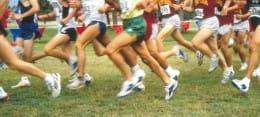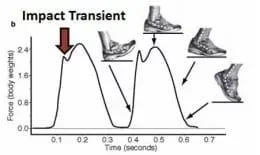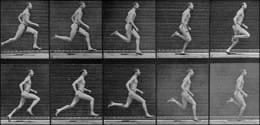Biomechanics on the Brain: How I Improved My Running Performance
 For most healthy people, running comes naturally — but we’re not necessarily running with the best gaits. I realized this a few years back with the help of a gym mirror and then a personal trainer. By learning to pay attention to my running biomechanics, I improved my speed and endurance. Also, let’s not forget that running style and training can either promote or prevent injuries.
For most healthy people, running comes naturally — but we’re not necessarily running with the best gaits. I realized this a few years back with the help of a gym mirror and then a personal trainer. By learning to pay attention to my running biomechanics, I improved my speed and endurance. Also, let’s not forget that running style and training can either promote or prevent injuries.
Each of us has our own biomechanics to work with, but a few recommendations should apply to runners in general. Here are some tips on what I have learned through my experience.
Analyze your gait.
If you can use a treadmill, get a videotape of yourself in action. Slow down the playback to study your running style. This is crucial because the cycle of each running step is very fast; if you’re running at 180 strides per minute, you have only a fraction of a section to analyze each step.
If you’re not sure what to look for or can’t tape yourself, talk with a knowledgeable friend or a pro at your gym, or hire a personal trainer if you sense that something’s off.
One aspect to check out is your landing. After years of controversy (such drama in the running world), experts are in better agreement about optimum landing style: Land on the lower section of the ball of your foot. In other words, hit the ground where your toes meet the rest of the foot. (This is in contrast to choosing a heel-first landing, which many professionals used to recommend.) The Runner’s World image shown here depicts the shock associated with different landing styles, and the heel strike is clearly most jolting to our bodies.
When you land, your foot should be aligned with your chest. This happens most naturally when you’re running without an incline or decline. If you’re running up or down a hill though, you’ll need to compensate by tilting your body to maintain a perpendicular line to the ground.
Keep Posture on the Mind
Posture is an obvious factor in running performance. Imagine a line running perpendicular to the ground. It runs straight up your back as you run, keeping you perfectly aligned with the pull of gravity. When runners tilt forward, personal trainers say that they “over-pronate.” Not everybody will wind up with an injury, but tilting isn’t the best option.
If you’re running outside, then looking straight ahead and at least 10 feet into the distance can promote an upright position. Maintaining this posture might not be so easy if you use an indoor treadmill and have your eyes glued to the console. If you have a home treadmill, consider moving it to where TV or an interesting scene can be seen from 10 feet away.
Also, sometimes people start to slouch when a run becomes tiring. When this happens, it might be best to take a break and rehydrate. Running with poor biomechanics isn’t the best choice in the long run if it leads to shin splints or other injuries.
Relax
Relax and run? I learned from a trainer to keep my hands relaxed while running. I had been tightening my fists without realizing it, and she pointed out that I was adding a negative sort of tension to my runs. When I loosely cupped my hands, my wrists move more freely, my knees followed suit, and my gait felt more natural than before.
Find a Better Stride Frequency
Do you know your stride frequency? As you would guess, stride frequency is the number of times per minute that one of your legs completes a full stride cycle. As your speed increases, so does your stride frequency.
How do running biomechanics figure in? When you use the best stride frequency, you reduce the oxygen costs and the energy costs of running. Many factors influence stride frequency, such as hip flexibility, state of fatigue, and of course leg length. Some of these factors are under your control and some clearly are not. With smart trial and error, and ideally with coaching, you can determine the best stride length for your body.
Most of us have running stride frequencies of about 160 to 180 strides per minute. You can calculate your stride frequency by counting the number of times your favorite foot hits the ground in one minute. Then multiply by two. So, for example, if your left foot hits the ground 90 times per minute, you have a stride frequency of 180.
Remember to take care with your stride frequency tests. A sudden increase is workout intensity is a primary cause of injuries to runners!
Strengthen Your Ankles
The stronger your ankles, the more powerful your gait and the less likely sprains become. One drill I learned for ankle strengthening involves balancing on one leg with the other bent slightly, so your ankle will be at mid-calf height. Using a perfect upright posture, raise up on the ball of your foot to strengthen your Achilles tendon. Keep your legs and hip slightly flexed as you hold this position for ten seconds if you can, and let your upper body be relaxed. Then take a break, walk for a few seconds, and repeat the process several times with each leg.
The above exercise is called the “pose drill.” It was developed by Romanov and promoted in “Developing Improved Running Mechanics,” an article in a 2001 USA Triathlon newsletter.
Final Thoughts
Biomechanics can really make a difference to performance. Imagine that one runner has a smooth arm swing and straight posture. Another leans at the waist and has stiff arms. All things being equal the first runner will win a race between the two. They are getting more aerobic power even if they’re using the same percentage of their maximum VO2 (oxygen uptake). The superior gait also tones muscles more efficiently and makes injuries less likely. Become a biomechanics scientist in your own gym! I know it has helped me a ton and you too will be glad you took the time as your runs become better than ever!
Other Treadmill Reviews:
- Test HomePage
- NordicTrack Commercial X14i
- Echelon Stride
- NordicTrack C 590 Pro
- NordicTrack T 7.5 S - Pros & Cons (2024)
- Sole TD80 Treadmill Desk
- NordicTrack Commercial X11i
- NordicTrack T 8.5 S - Pros & Cons (2024)
- Horizon Elite T5
- Exerpeutic TF1000
- NordicTrack T 6.5 S - Pros & Cons (2024)
- ProForm Sport 5.0
- ProForm Premier 900
- ProForm ZT6
- NordicTrack FreeStride Trainer FS5i (Discontinued)
- Bowflex Max Trainer M5
- BowFlex TreadClimber TC100
- ProForm Power 795
- ProForm Sport 7.0
- NordicTrack Incline Trainer X15i
- NordicTrack C 1650 Treadmill
- Horizon Elite T9
- Official Boston Marathon Treadmill 4.0
- NordicTrack Treadmill Desk
- NordicTrack C 1630 Pro
- NordicTrack C 970 PRO



